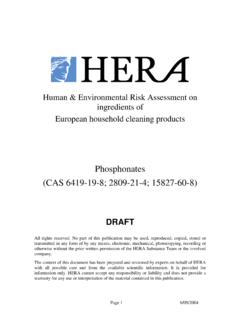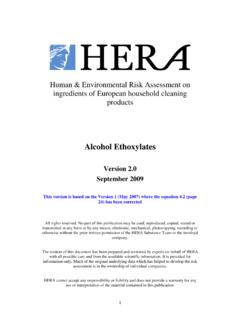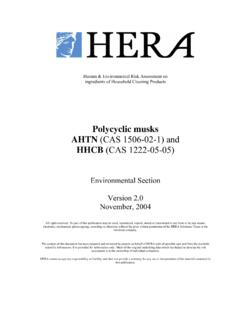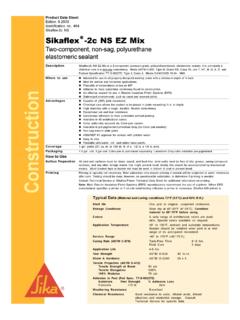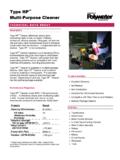Transcription of HERA Human & Environmental Risk Assessment - …
1 Human & Environmental Risk Assessment on ingredients of household cleaning products Subtilisins (Protease). CAS No: 9014-01-1, 1395-21-7, 9073-77-2, 9001-92-7, 79986-26-8, 95979-76-3, 68909-17-1. Edition February 2007. All rights reserved. No part of this publication may be used, reproduced, copied, stored or transmitted in any form or by any means, electronic, mechanical, photocopying, recording or otherwise without the prior written permission of the hera Substance Team or the involved company. The content of this document has been prepared and reviewed by experts on behalf of hera with all possible care and from the available scientific information.
2 It is provided for information only. Much of the original underlying data which has helped to develop the risk Assessment is in the ownership of individual companies. hera cannot accept any responsibility or liability and does not provide a warranty for any use or interpretation of the material contained in this publication. 1. SUBTILISIN hera Report 1. EXECUTIVE SUMMARY. Subtilisins are proteolytic enzymes, mainly (>90 %) used in detergents and household cleaning products to remove proteinaceous deposits and stains. Subtilisins are of bacterial origin, and are produced by a fermentation process. The total amount of Subtilisin produced and used in the European Union in 2002 was about 1,000 tons of pure enzyme.
3 The protease used in detergents is a globular protein with an average molecular weight of 27,000, consisting of 269 to 275 amino acids. The enzyme is characterised by amino acid sequence and three-dimensional structure as well by its biocatalytic activity in hydrolysing amino acid esters, amides and peptide bonds. The enzyme is active from pH 6 to 11, with a major activity in the pH range between 9 and 11. Subtilisins show good solubility but little stability in water. Subtilisins are used in automatic dish wash detergents and in all types of powder and liquid household laundry detergents, and in laundry bleach additives.
4 They are also used in industrial cleaning and laundering products. Minor quantities (<10%) are used in technical applications such as protein hydrolysate production, leather treatment, and in the textile and cosmetics industry. The Subtilisin concentration in household detergent and cleaning products is very low and depends on the type of product. The Subtilisin concentrations in products typically range between %. and %. Environmental Assessment Subtilisins are proteins which are readily and ultimately biodegradable in the environment. Consequently, they are removed to a very high extent (> 99%) in sewage treatment plants as shown in simulation model tests and monitoring studies.
5 An important aspect in the Environmental exposure Assessment is the fact that these enzymes are inactivated to a large extent under washing or cleaning conditions. Taking account of the existing facts and study results, an 80% reduction of protease activity in the washing process was conservatively assumed. Based on evidence that the inactivation of proteases is equivalent to the loss of their ecotoxic properties, the risk Assessment has to take this fact into account. The existing data on acute aquatic toxicity of Subtilisin cover a broad range of EC50 values ( - 50 mg of active enzyme/l). The Predicted No Effect Concentration (PNEC) was conservatively derived from the lowest effect concentration in spite of seeming atypically low compared to the majority of the data.
6 Therefore this PNEC-dertermining toxicity value is unsuitable to form the basis for the Environmental classification of Subtilisins. Based on the hera detergents exposure scenario, the Environmental risk characterisation of Subtilisin revealed risk characterisation ratios below 1 in all Environmental compartments. This allows the conclusion that the use of proteases in detergents does not provide a risk for the environment. Human Health Assessment The key health concern identified for Subtilisin is respiratory (Type 1) allergy. Consumers can be exposed to Subtilisins via the respiratory route during the task of dispensing detergent products in the washing machine (exposure up to ng Subtilisin/m3) or during handwash of laundry ( ng/m3), or by suddenly opening the dish washer during the cleaning step (< ng/m3).
7 Since there is no well defined threshold for the induction of sensitisation a benchmark approach was used to assess the risk of consumers for respiratory allergy. An upper benchmark where allergic symptoms occur was established at 212 ng/m3. Allergic symptoms can be excluded when exposure does not exceed a range of 1 ng/m3 upon consumer use of laundry and cleaning products. There appears to be a complex relationship between frequency, magnitude and duration of 2. exposure and the generation of enzyme specific IgE antibody. Therefore a lower benchmark where risk of sensitisation is clearly absent cannot be given with sufficient accuracy.
8 Since enzyme exposure associated with laundry products is calculated to be not more than ng/m3, adverse effects are not expected. Even under the worst-case situation (opening a dishwasher during the cleaning step) such effects are not to be expected as in reality the thresholds at which respiratory sensitisation and allergy occur are likely to be distinctly higher than mentioned above, thus making, the margin of safety proportionately greater. Other than for respiratory allergy, there is also a hazard for skin and eye irritation by Subtilisins. Consumers may be exposed by skin contact during laundry hand wash (exposure up to a Subtilisin concentration of ), by laundry pre-treatment using liquid detergent ( ), by hand dish wash ( ) and by fabric wear with skin in contact with Subtilisin deposited during the wash ( g/cm2).
9 As aqueous solutions of Subtilisin at concentrations up to 2% enzyme granulate (estimated % aep) failed to show any irritation effects even on damaged Human skin, and as the average NOEC value for humans is at % (based on aep), it is concluded that skin contact with washing solutions containing Subtilisins is not a cause of concern. Skin contact with Subtilisin deposits on washed fabrics are not expected to cause skin irritation, as the levels of Subtilisin deposited on fabric are very small; even assuming all the material remains active and transfers to skin with 100% efficiency, the skin contact concentrations are several orders of magnitude below the No Observed Effect Concentration of % mentioned above.
10 Clinical studies which are in support of this conclusion have been published. In the course of laundry pre- treatment, skin contact with concentrated powder paste, or neat liquid detergent (maximum concentration ), may occur. If it does occur at all, the contact with skin is confined to a fraction of the hands (palms and/or fingers), and is of very short duration (typically a few minutes at most). The initially high Subtilisin concentration is usually diluted rapidly in the course of the pre-treatment task. Failing to rinse hands in water after contact with a laundry pre-treatment paste or liquid may result in (transient) skin irritation of the hands, which is expected to be mild in nature and can be easily avoided by prompt washing with water.




